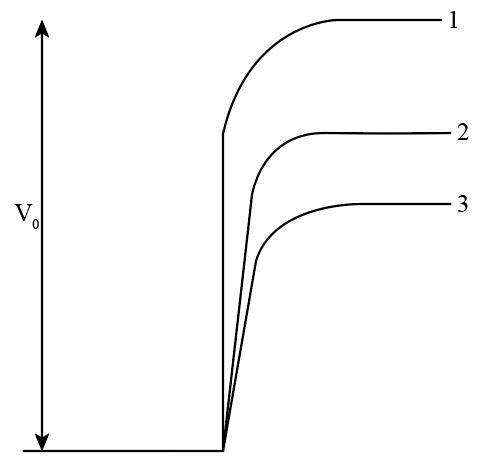
The following figure which is given is the potential barrier across a P-N junction, when no battery is connected across the junction:

A. 1 and 3 both correspond to forward bias of junction
B. 3 correspond to forward bias of junction and 1 corresponding to reverse bias of junction
C. 1 corresponds to forward bias and 3 corresponds to reverse bias of the junction.
D. 3 and 1 both correspond to reverse bias of junction.

Answer
562.8k+ views
Hint: This question is about p-n-p Junction from the chapter of semiconductors. In this question there is a graph given to us which is of stopping potential also known as the potential barrier. We have to analyze the different potential barrier values and find the biasing in the circuit of the junction.
Complete step by step answer:
When a P-N-P junction is forward biased it opposes the potential barrier, and the potential barrier is reduced and the current in the circuit is more. This is because the potential at both sides of the potential barrier is opposite as the concentration of charges naturally. Therefore, the charges attract and the value decreases.
When a P-N-P junction is reverse biased, it supports the potential barrier and increases its value, resulting in the current in the circuit is very less and almost negligible. This is because the potential at both sides of the potential barrier is the same as the concentration of charges naturally. Therefore, the charges repel and the value increases.
Hence, we can say that in forward biasing of the P-N-P junction the value of the potential barrier is less, and when a P-N-P junction is Reverse biased the value of the potential barrier is the most.
Now when we see the graph, the potential barrier number 1 has the largest value; therefore, it should be of the forward biasing of the circuit.
And when we see the potential barrier number 3 it is of the least value hence it should be of the reverse biasing of the circuit.
Thus, the correct option is (C).
Note:
This is a kind of question in which understanding of the biasing process of the semiconductors is very important. Also, students are able to see and visualize the graph of the potential barrier and the greater and lesser values of it and the reason behind those values. If all of these are kept in mind the students can easily answer these kinds of questions.
Complete step by step answer:
When a P-N-P junction is forward biased it opposes the potential barrier, and the potential barrier is reduced and the current in the circuit is more. This is because the potential at both sides of the potential barrier is opposite as the concentration of charges naturally. Therefore, the charges attract and the value decreases.
When a P-N-P junction is reverse biased, it supports the potential barrier and increases its value, resulting in the current in the circuit is very less and almost negligible. This is because the potential at both sides of the potential barrier is the same as the concentration of charges naturally. Therefore, the charges repel and the value increases.
Hence, we can say that in forward biasing of the P-N-P junction the value of the potential barrier is less, and when a P-N-P junction is Reverse biased the value of the potential barrier is the most.
Now when we see the graph, the potential barrier number 1 has the largest value; therefore, it should be of the forward biasing of the circuit.
And when we see the potential barrier number 3 it is of the least value hence it should be of the reverse biasing of the circuit.
Thus, the correct option is (C).
Note:
This is a kind of question in which understanding of the biasing process of the semiconductors is very important. Also, students are able to see and visualize the graph of the potential barrier and the greater and lesser values of it and the reason behind those values. If all of these are kept in mind the students can easily answer these kinds of questions.
Recently Updated Pages
Master Class 12 Economics: Engaging Questions & Answers for Success

Master Class 12 Maths: Engaging Questions & Answers for Success

Master Class 12 Biology: Engaging Questions & Answers for Success

Master Class 12 Physics: Engaging Questions & Answers for Success

Basicity of sulphurous acid and sulphuric acid are

Master Class 12 Business Studies: Engaging Questions & Answers for Success

Trending doubts
How much time does it take to bleed after eating p class 12 biology CBSE

Explain sex determination in humans with line diag class 12 biology CBSE

Differentiate between homogeneous and heterogeneous class 12 chemistry CBSE

When was the first election held in India a 194748 class 12 sst CBSE

Explain sex determination in humans with the help of class 12 biology CBSE

December 10th of 1948 is an important day in the history class 12 sst CBSE




